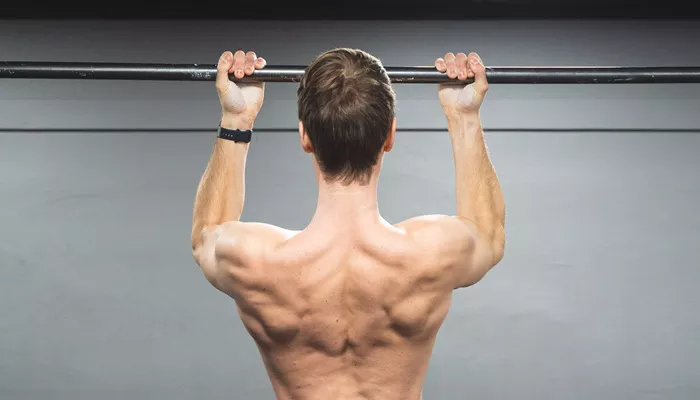Chin-ups are one of the most effective bodyweight exercises for building upper body strength. They primarily target the muscles in your back, arms, and shoulders. This article will explore the details of chin-ups, including their benefits, proper techniques, variations, and how to integrate them into your fitness routine.
Understanding Chin-Ups
Chin-ups are a form of pull-up exercise where you lift your body by pulling yourself up on a bar. Your palms face toward your body with your arms bent at the elbows. The chin-up is a compound movement that engages multiple muscle groups. It is typically performed using a horizontal bar. Unlike some exercises that focus on a single muscle group, chin-ups offer a full-body workout.
The Muscles Targeted by Chin-Ups
The primary muscles targeted during chin-ups are:
- Latissimus dorsi (lats): These muscles give your back a V-shape and are responsible for pulling your arms down.
- Biceps: The biceps in your upper arms are heavily involved in the pulling motion during chin-ups.
- Rhomboids and Trapezius: These muscles in your upper back help to stabilize your shoulder blades.
- Forearms: Your grip strength plays a crucial role in chin-ups, engaging your forearm muscles.
Chin-ups also activate core muscles as they stabilize your body throughout the movement. As an anaerobic exercise, chin-ups help to build strength, endurance, and muscle mass.
Why Are Chin-Ups Important?
Chin-ups are essential for anyone looking to increase upper body strength. Unlike many exercises that isolate muscles, chin-ups work several muscle groups simultaneously. They also improve grip strength, which is essential for other exercises like deadlifts, rows, and even anaerobic exercises at home.
The Benefits of Chin-Ups
- Enhanced Upper Body Strength: Chin-ups increase the strength of your lats, biceps, and shoulders.
- Improved Grip Strength: Holding onto the bar strengthens your forearms and grip, essential for lifting exercises.
- Core Activation: Chin-ups require you to engage your core muscles to keep your body stable throughout the movement.
- Functional Fitness: Chin-ups mimic real-world movements, making them an excellent choice for functional fitness.
Chin-ups are also beneficial for improving posture, as they strengthen the upper back and shoulders. A strong back supports better spinal alignment and reduces the risk of back pain.
How to Perform a Chin-Up
Performing chin-ups correctly is essential to avoid injury and maximize benefits. Here’s a step-by-step guide on how to execute a chin-up:
- Grab the Bar: Stand under the pull-up bar and grasp it with an underhand grip (palms facing toward you). Your hands should be shoulder-width apart.
- Engage Your Core: Tighten your core and keep your body straight. Avoid swinging your legs or using momentum to help with the lift.
- Pull Yourself Up: Pull your body upward by bending your elbows and drawing your shoulder blades down. Focus on using your back and arms to lift your body.
- Reach the Top: Aim to get your chin above the bar. Hold for a second at the top.
- Lower Yourself: Slowly lower your body back to the starting position, fully extending your arms without letting your shoulders relax.
It’s essential to perform chin-ups in a controlled manner, focusing on proper form rather than speed. Doing so will reduce the risk of injury and ensure that you are maximizing the exercise’s benefits.
Common Chin-Up Mistakes to Avoid
While chin-ups are effective, many individuals make mistakes that hinder their progress. Here are a few common errors to watch out for:
- Using Momentum: Jerking or swinging your body to complete a chin-up takes the focus off the target muscles and increases the risk of injury.
- Not Fully Extending Arms: Failing to fully extend your arms at the bottom of the movement can limit the range of motion and reduce the exercise’s effectiveness.
- Not Engaging the Core: Failing to engage the core during chin-ups can lead to lower back strain and improper form.
Chin-Up Variations for Different Fitness Levels
Chin-ups can be modified to suit different fitness levels. If you are a beginner or unable to perform a full chin-up, consider the following variations:
Assisted Chin-Ups
Assisted chin-ups involve using a resistance band or an assisted pull-up machine to help lift part of your body weight. This allows you to practice the movement while gradually building strength.
Negative Chin-Ups
Negative chin-ups focus on the lowering phase of the exercise. Start at the top of the movement (with your chin above the bar) and slowly lower yourself down. This helps to build strength in the muscles involved in the chin-up.
Chin-Up Hold
Chin-up holds involve holding your chin above the bar for an extended period. This variation helps to build grip strength and endurance.
Integrating Chin-Ups into Your Fitness Routine
To get the best results from chin-ups, integrate them into your fitness routine effectively. Here are a few tips on incorporating chin-ups into your workout plan:
- Warm-Up: Always perform a warm-up before attempting chin-ups to prepare your muscles for the movement and prevent injury.
- Incorporate Chin-Ups into a Full-Body Routine: Include chin-ups as part of your upper body or full-body workout routine. They complement exercises like push-ups, rows, and dips.
- Increase Difficulty Over Time: Gradually increase the number of chin-ups you perform or add weight to make the exercise more challenging.
Chin-Ups and Anaerobic Training
Chin-ups are an anaerobic exercise, meaning they require short bursts of high-intensity effort. They are ideal for building strength, as anaerobic exercises focus on muscle growth and power.
Conclusion
Chin-ups are a fundamental exercise for developing upper body strength. By understanding their benefits, proper form, and variations, you can effectively incorporate chin-ups into your fitness regimen. Whether you’re a beginner or an advanced athlete, chin-ups will help you achieve your strength goals and improve overall fitness.

